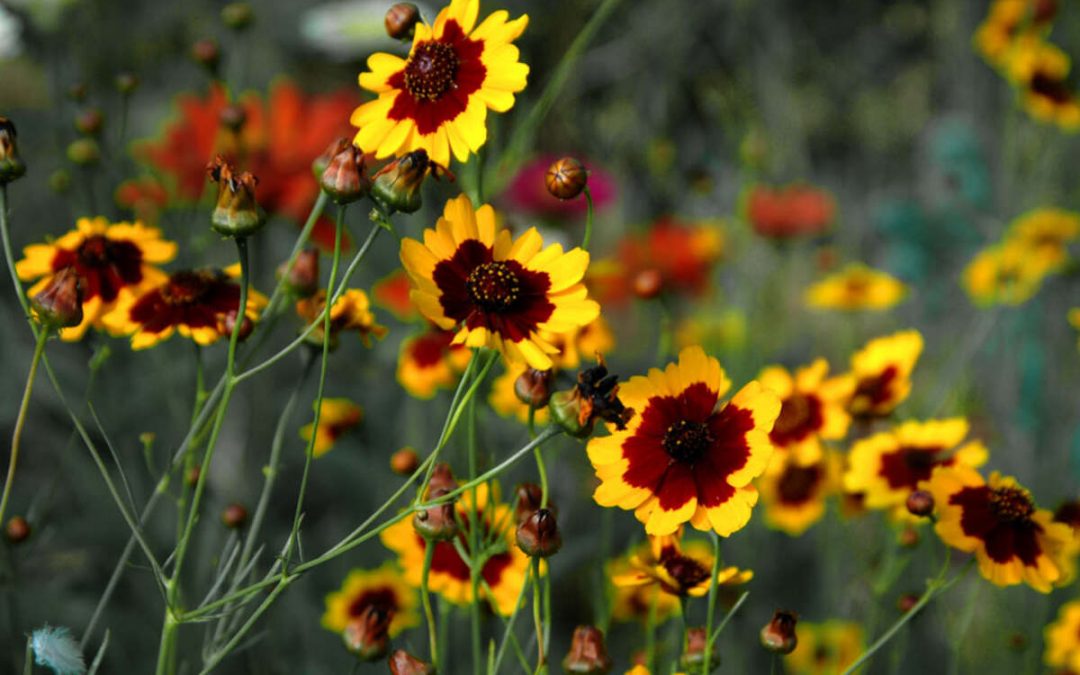Known as the Magnolia State, Mississippi boasts a variety of native plants that are adapted to its humid, subtropical climate. Native plants are hardy and low-maintenance and make excellent plants for beginners.
We’ve compiled a list of the 13 best native plants for Mississippi to provide your landscape with a multitude of benefits, including:
- Native plants are low-maintenance and accustomed to Mississippi’s Natchez silt loam soil and climate.
- They require fewer pesticides and fertilizers, reducing environmental impact.
- They support wildlife and beneficial pollinators.
In this article, we will cover:
- 13 Best Native Plants for Your Mississippi Yard
- How to Choose the Best Mississippi Natives for Your Landscape
- Where to Find Native Plants in Mississippi
13 Best Native Plants for Your Mississippi Yard
If you’re looking to add some fresh color, texture, or flair to your garden and want to tap into all the perks native plants offer, read on to discover the best options for your Mississippi landscape.
1. American Beautyberry (Callicarpa americana)
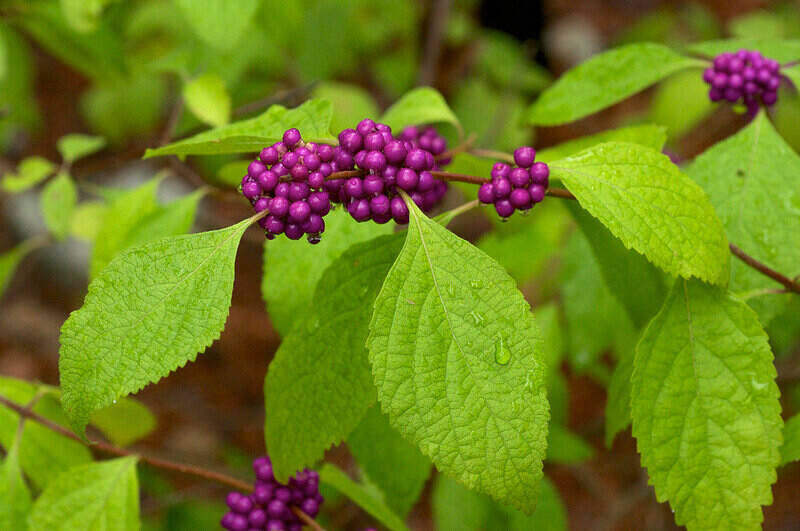
Photo Credit: Eric Hunt / Wikimedia Commons / CC BY-SA 3.0
American beautyberry is a shrub found in the southeastern United States. It has a moderate growth rate and can be planted in fall or spring. Beautyberry’s flowers and medium green foliage are fairly unspectacular, but its clusters of glossy purple berries are quite the showstoppers. The edible fruits appear in late summer or early fall and persist into winter, providing visual interest and food for wildlife like deer and birds.
Beautyberry is relatively disease and pest-resistant and can survive for decades in the right conditions. The fruit-bearing shrub drops seeds that remain dormant in the ground until bursting to life after the original plant has reached the end of its lifespan.
Growth habit: Shrub
USDA hardiness zone: 7-11
Mature size: 3-8 feet tall and 4-8 feet wide
Duration: Perennial
Foliage: Deciduous
Sunlight needs: Full sun to partial shade
Soil preferences: Adaptable; prefers well-drained, nutrient-rich soil but tolerates acidic, sandy soil
Water needs: Drought-tolerant; prefers a regular watering schedule and moist roots
Potential hazards: Non-toxic; cooked fruit can be made into jelly
2. Azalea (Rhododendron)
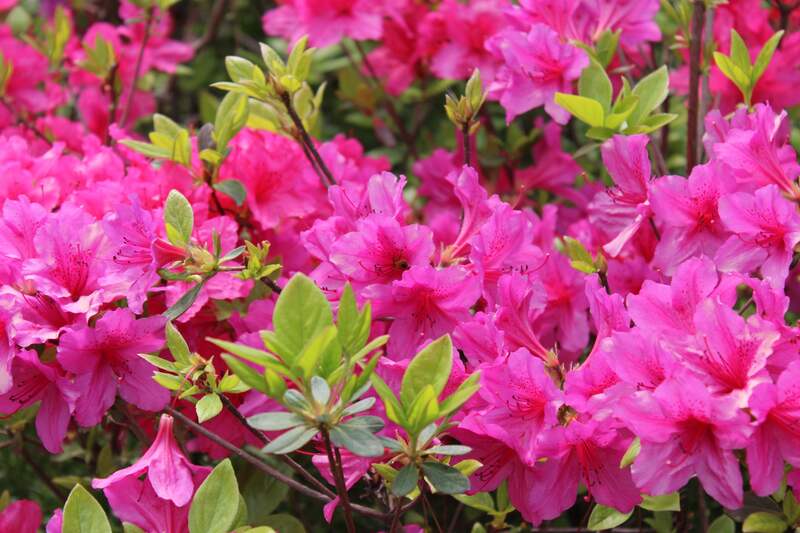
Photo Credit: Pxfuel
Can you think of a more captivating sight in the spring than flowers in full bloom? Azaleas are loosely branched, shade-loving plants with elliptical leaves. Specimens produce clusters of bell-shaped, tubular flowers that bring delightful color and native pollinators to all corners of your spring garden.
Most azaleas bloom in mid to late April. Some cultivars are temperamental if growing conditions aren’t to their liking. They prefer loose, well-drained, and slightly acidic soil and can live for up to 50 years if properly cared for.
Growth habit: Shrub
USDA hardiness zone: 6-9
Mature size: 4-12 feet tall and wide
Duration: Perennial
Foliage: Deciduous
Sunlight needs: Partial shade
Soil preferences: Prefers well-drained, rich, humusy, acidic, moisture-retentive soils
Water needs: About 1 inch of water or rainfall per week
Potential hazards: Toxic; poisonous to humans and animals
3. Box Elder (Acer negundo)
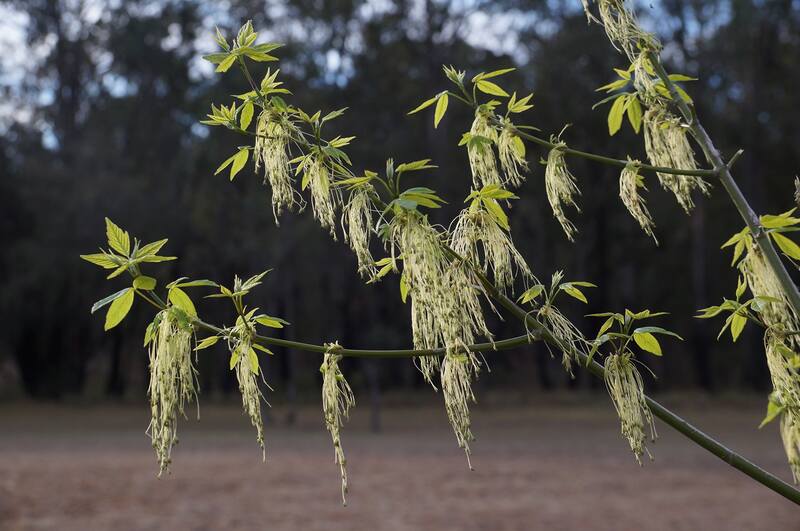
Photo Credit: Tatters / Flickr / CC BY 2.0
Box elder is a fast-growing, adaptable, native maple tree that is drought resistant. Unfortunately, it doesn’t provide ornamental appeal for many homeowners. In the wild, box elders grow on river banks, providing erosion control and shelter for wildlife. It has a short trunk, light green foliage, and spreading branches. Unlike other maples, it grows irregularly and has a sprouting base and compound leaves.
Box elder has brittle, weak wood that doesn’t stand up to high winds or ice. The seeds germinate quickly and can be a nuisance in a residential garden. Female specimens attract its namesake insects, boxelder bugs, which live inside the trees during winter.
Growth habit: Tree
USDA hardiness zone: 2-10
Mature size: 30-50 feet tall and wide
Duration: Perennial
Foliage: Deciduous
Sunlight needs: Full sun
Soil preferences: Adaptable; chalk, clay, loam, or sand
Water needs: Water deeply every 7 to 10 days
Potential hazards: Toxic; poisonous to horses
4. Coreopsis (Coreopsis tinctoria)
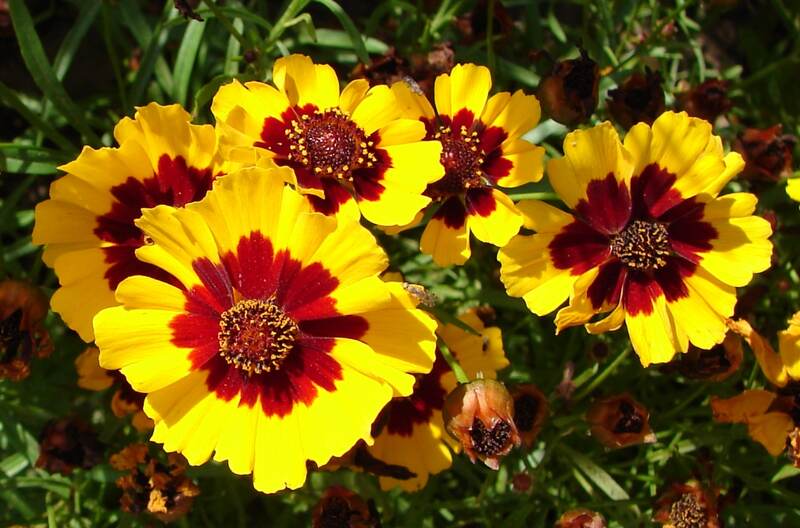
Photo Credit: Ogrodnikk / Wikimedia Commons / CC BY-SA 3.0
Coreopsis, also known as tickseed, golden wave, and calliopsis, is a slender plant. It is the perfect choice if you’re looking for a low-maintenance, drought-tolerant, long-blooming flowering plant to fill a bed or line a border in your yard.
Showy, yellow, daisy-like flowers have little scent, but the light green foliage smells like anise. Coreopsis are native to North America, grow in upright clumps, and flower throughout the summer.
The nickname, tickseed, is a nod to its tick-like round seeds that serve as delicious snacks for birds and other wildlife during fall and winter, while the colorful blooms are a magnet for bees and butterflies.
Growth habit: Herbaceous flower
USDA hardiness zone: 4-11
Mature size: 1-4 feet tall and 1-2 feet wide
Duration: Perennial
Foliage: N/A
Sunlight needs: Partial shade
Soil preferences: Adaptable; prefers moist, well-drained chalk, soil, sand, loam, or clay
Water needs: Drought-tolerant; 1 inch of rainfall or water per week
Potential hazards: Non-toxic, no safety hazards
5. Crossvine (Bignonia capreolata)
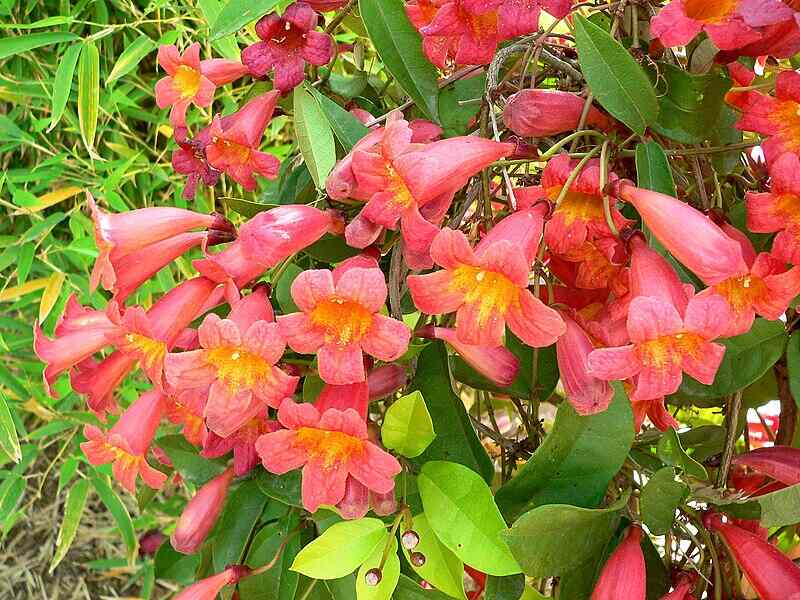
Photo Credit: Stan Shebs / Wikimedia Commons / CC BY-SA 3.0
Crossvine is a woody climbing vine with orange-red, trumpet-shaped flowers that are magnets for pollinators like the ruby-throated hummingbird. You can find specimens in woods, swamps, hedgerows, hammocks, and limestone escarpments throughout the southeastern United States.
Crossvine can grow impressively tall by anchoring itself to nearby trees. Its leaves are bright green during the growing season and turn a reddish-purple in winter. Though this plant is immune to most pests and low-maintenance, the fast-growing vine can be a nuisance.
Growth habit: Vine
USDA hardiness zone: 6-9
Mature size: 30-50 feet tall and 6-9 feet wide
Duration: Perennial
Foliage: Semi-evergreen
Sunlight needs: Full sun; partial shade
Soil preferences: Adaptable; moist, well-drained chalk, clay, loam, or sand
Water needs: Maintain moist soil
Potential hazards: Non-toxic; no safety hazards
6. Eastern Bluestar (Amsonia tabernaemontana var. salicifolia)
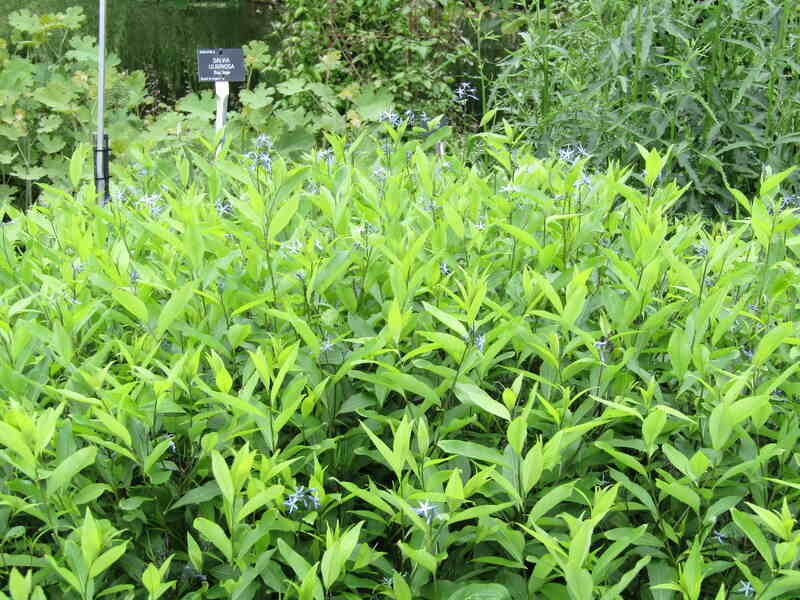
Photo Credit: Leonora (Ellie) Enking / Flickr / CC BY-SA 2.0
Known for its fluffy clusters of soft, blue, star-shaped flowers, eastern bluestar is a medium-sized, low-maintenance plant. Its airy but substantial foliage is versatile, suiting all landscape designs. In fall, specimens turn a brilliant yellow color.
Bluestar produces narrow, lance-shaped leaves with pronounced ribs. Specimens bloom in spring, followed by interesting seed pods. It grows well alongside leafy plants like peonies and hostas.
Growth habit: Flower
USDA hardiness zone: 3-9
Mature size: 1-3 feet tall and wide
Duration: Perennial
Foliage: Deciduous
Sunlight needs: Full sun; partial shade
Soil preferences: Adaptable; moist, well-drained sand, chalk, clay, or loam
Water needs: Drought-tolerant; water once per week
Potential hazards: Low toxicity; milky sap irritates humans and animals
7. Flowering Dogwood (Cornus florida)
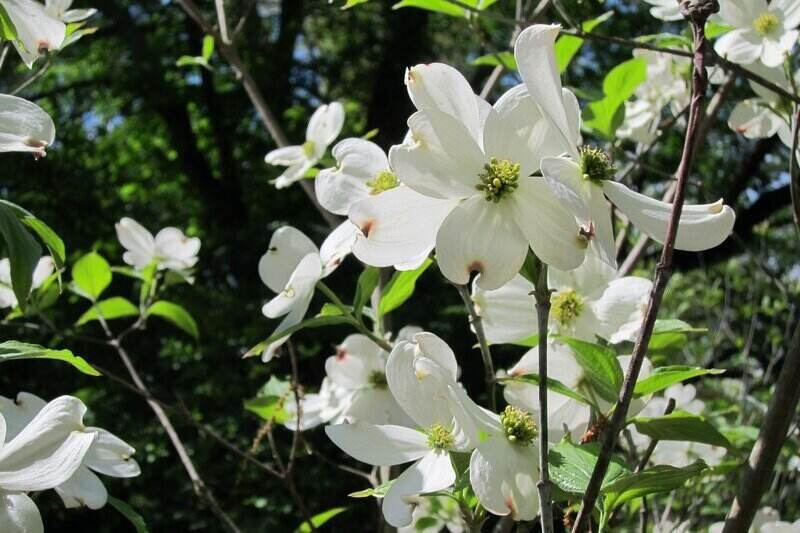
Photo Credit: Hippopx
Flowering dogwood is a low-maintenance understory tree that blooms in its second year. It grows well in full sun or partial shade, prefers a soil pH between 5.5 to 6, and likes open woodland settings.
Sometimes considered the most spectacular of the native flowering trees, the flowering dogwood is single or multi-trunked with a spreading crown and showy blossoms that bloom in shades of pink, red, and white. It boasts horizontal-tiered branches, red fruits, and scarlet fall leaves.
Growth habit: Tree
USDA hardiness zone: 5-9
Mature size: Between 20-25 feet tall and 12-18 feet wide
Duration: Perennial
Foliage: Deciduous
Sunlight needs: Full sun; partial shade
Soil preferences: Moist, well-drained, acidic clay, loam, or sand
Water needs: Drought-tolerant; water one inch per week
Potential hazards: Toxic; poisonous fruit
8. Northern Catalpa (Catalpa speciosa)
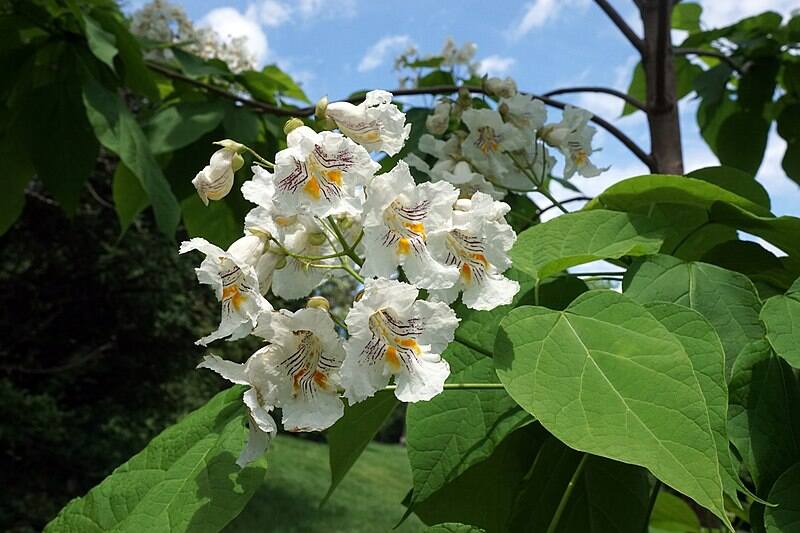
Photo Credit: Plant Image Library / Wikimedia Commons / CC BY-SA 2.0
Also known as cigar tree and Indian bean, northern catalpa is a medium-sized tree with showy, white, fragrant flowers, large heart-shaped leaves, and dangling seed pods that look like beans and persist through winter.
Northern catalpa is low-maintenance and best suited to large, open spaces. Unfortunately, once the flowers, pods, and leaves drop, you’ll need to invest in some landscape cleanup. Avoid planting this tree near sidewalks and driveways. Specimens prefer at least six hours of sunlight per day and tolerate a range of moisture conditions, including flooding.
Growth habit: Tree
USDA hardiness zone: 4-8
Mature size: 40-70 feet tall and 20-50 feet wide
Duration: Perennial
Foliage: Deciduous
Sunlight needs: Full sun; partial shade
Soil preferences: Adaptable; moist, well-drained clay, loam, chalk, or sand
Water needs: Water one inch per week
Potential hazards: Non-toxic; no safety hazards
9. Orange Milkweed (Asclepias tuberosa)
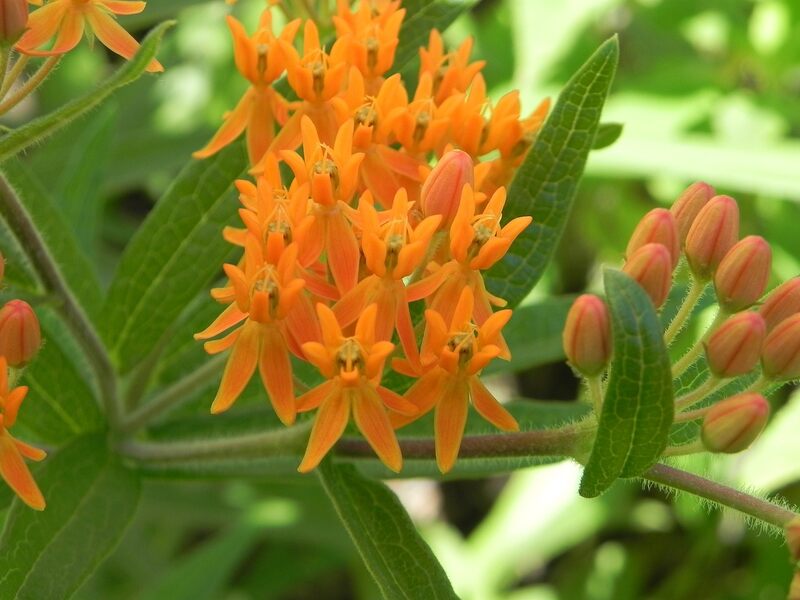
Photo Credit: Pixabay
Orange milkweed, or butterfly weed, is a bushy perennial that sports large, flat-topped clusters of orange flowers atop long stems. It has five sepals, five petals, and stiff, lance-shaped, glossy leaves that provide a dark green backdrop for the showy flowers.
This plant is beloved for its ability to attract a variety of beneficial insects to the garden. It is fairly slow-growing and is best planted in late spring after the soil warms. If left to its own devices, orange milkweed will become invasive and spread. Generally, it’s a low-maintenance plant found in meadows, prairies, and forest clearings.
Growth habit: Herbaceous flower
USDA hardiness zone: 3-10
Mature size: 1-4 feet tall and less than 1 foot wide
Duration: Perennial though some species are annuals
Foliage: N/A
Sunlight needs: Full sun
Soil preferences: Prefers dry, sandy soil or gravel
Water needs: Semi drought-tolerant; prefers to dry out between waterings
Potential hazards: Low toxicity; milky sap irritates humans and animals
10. Pignut Hickory (Carya glabra)
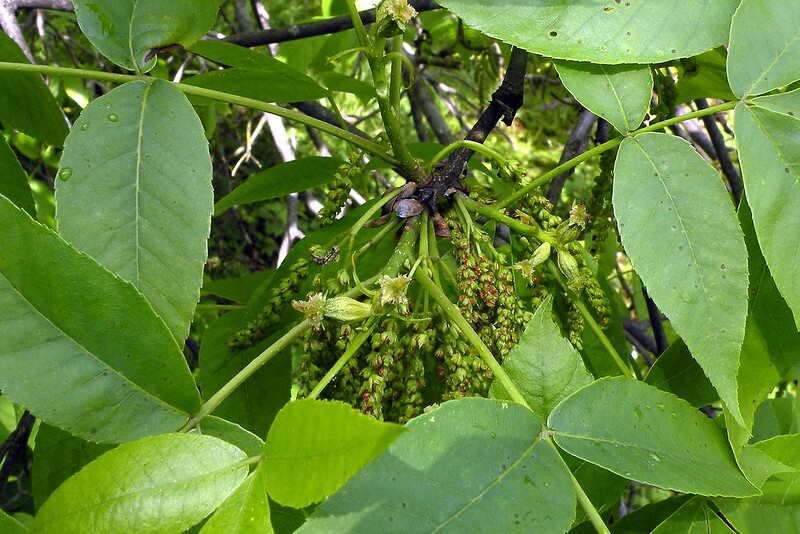
Photo Credit: Doug McGrady / Flickr / CC BY 2.0
Pignut hickory is a strong, large tree with a straight trunk and a dense, oval form. It is drought-tolerant and difficult to transplant once established thanks to a deep taproot. The pignut hickory is native to the eastern, southeastern, and central regions of the United States.
Pignut hickory produces bitter nuts, attracting a variety of wildlife. It is disease and pest-resistant and does not require routine pruning. It prefers full sun but is tolerant of shady Mississippi landscapes.
Growth habit: Tree
USDA hardiness zone: 5-9
Mature size: 50-80 feet tall and 25-40 feet wide
Duration: Perennial
Foliage: Deciduous
Sunlight needs: Full sun; partial shade
Soil preferences: Adaptable; moist, well-drained, chalk, loam, or sand
Water needs: Drought-tolerant; does not require watering outside of natural rainfall
Potential hazards: Non-toxic; no safety hazards
11. Red Buckeye (Aesculus pavia)
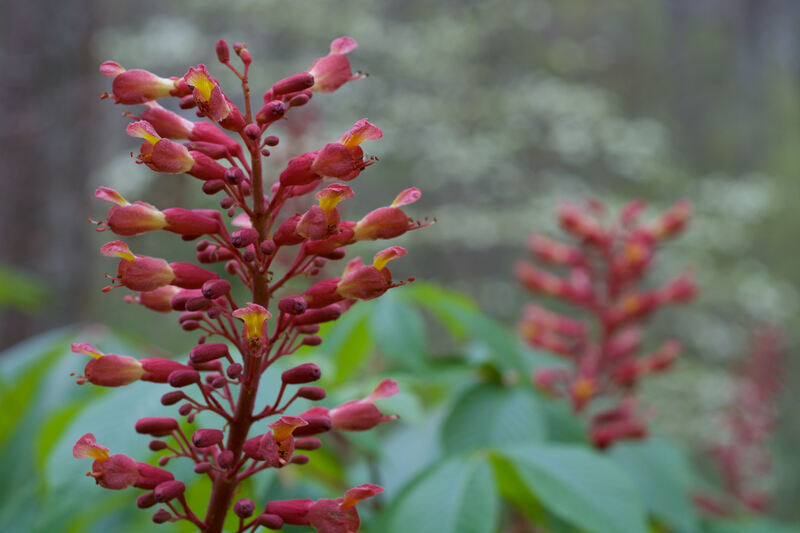
Photo Credit: Eric Hunt / Wikimedia Commons / CC BY-SA 4.0
This native plant is also known as the firecracker plant or scarlet buckeye, thanks to its upright clusters of red flowers. Red buckeye grows in the southern and eastern United States as a large shrub or small tree. While it doesn’t produce fall colors, its coarse texture and interesting form provide an attractive winter backdrop.
Red buckeye is a great understory tree, preferring shade and moisture. It is an extremely well-behaved plant, never extending aggressively, although squirrels spread seedlings. Flowering is consistent, even in dense shade. Specimens have palmate leaves and hard, round seed capsules.
Growth habit: Shrub, tree
USDA hardiness zone: 4-8
Mature size: 10-40 feet tall; usually 20 feet tall in Arkansas
Duration: Perennial
Foliage: Deciduous
Sunlight needs: Partial shade
Soil preferences: Prefers deep, acidic, well-drained sand, clay, loam, or limestone
Water needs: 1 inch of water or rainfall per week
Potential hazards: Moderate toxicity; seeds are poisonous to humans and animals, including horses and livestock; often used to make soap
12. Red Maple (Acer rubrum)
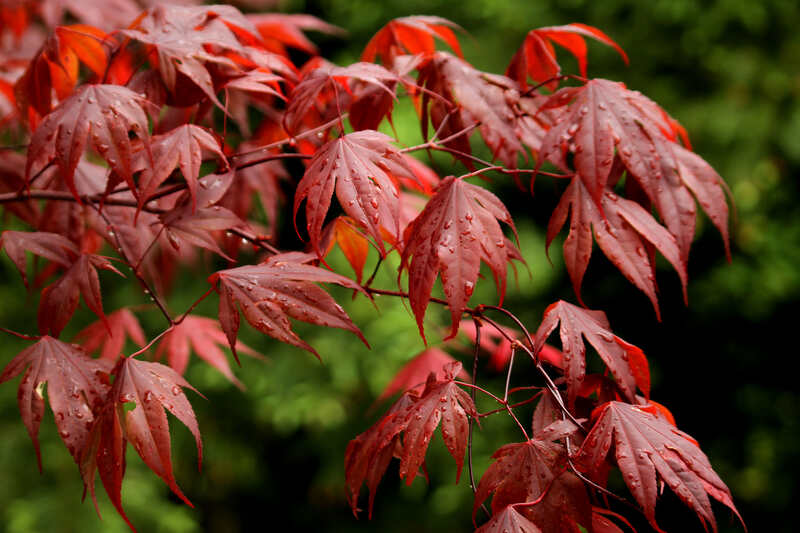
Photo Credit: Heng Wang / Wikimedia Commons / CC BY-SA 3.0
Red maple, also known as swamp maple, water maple, and Canadian maple, is a tall tree native to most of North America. It is named for its rich, highly desirable, bright red, fall foliage. During spring and summer, its leaves are bright green.
Red maple is a popular choice for yards, providing beautiful color and shade. It is easy to care for and grows well throughout all the seasons, making it a great low-maintenance landscape tree for beds and borders.
Growth habit: Tree
USDA hardiness zone: 3-9
Mature size: 40-70 feet tall and 30-50 feet wide
Duration: Perennial
Foliage: Deciduous
Sunlight needs: Full sun; partial shade
Soil preferences: Moist, well-drained, sand, loamy, chalk, or clay
Water needs: Maintain moist soil with slow, deep watering
Potential hazards: Non-toxic; no safety hazards
13. Whitemouth Dayflower (Commelina erecta)
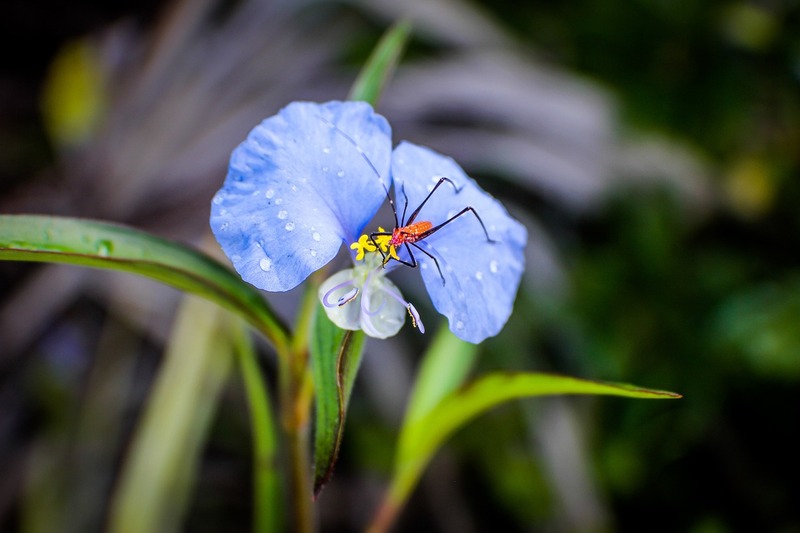
Photo Credit: Pixabay
Whitemouth dayflower, also known as slender dayflower, is an erect, perennial wildflower found in pinelands, coastal uplands, and scrub habitats. It is one of two native species of commelina. ‘Dayflower’ refers to the ephemeral nature of the flowers. Specimens of whitemouth dayflower open in the morning and close in the afternoon.
Showy blooms have two large, ear-like, purplish-blue petals and a smaller, white petal that appears below the ears, giving the appearance of a small, white mouth. Whitemouth dayflower sports long, curved, pale purple stamens, bright yellow pistils, and linear, lance-shaped leaves. Stems are soft and jointed.
Whitemouth dayflower blooms in summer and fall. Blooms invite a variety of pollinators to your garden, and local songbirds love to snack on their seeds.
Growth habit: Flower
USDA hardiness zone: 7-11
Mature size: 1-2 feet tall and 1 foot wide
Duration: Perennial
Foliage: Deciduous
Sunlight needs: Full sun; partial shade
Soil preferences: Well-drained sand
Water needs: Water once per week; increase watering to twice per week during hot, dry weather
Potential hazards: Non-toxic; no safety hazards
How to Choose the Best Mississippi Natives for Your Landscape
All native plants have their own characteristics and needs. It is important to consider the sun exposure, soil type, and watering capabilities of your landscape.
Additionally, it is important to consider your hardiness zone when planting non-natives. Mississippi’s USDA zones are 7a to 8b, with the lowest annual temperatures ranging from 0 to 5 degrees Fahrenheit. All native plants are hardy to the Magnolia State’s minimum temperatures.
Where to Find Native Plants in Mississippi
Native plants, turfgrass, and other low-maintenance landscaping options come together to create your backyard oasis.
If you need help determining where to start, let Wikilawn connect you with a local pro so you can keep your weekends free for all of the really important things, like Netflix. Our trusted lawn care experts are spread out across Jackson, Southaven, Olive Branch, Pearl, Ridgeland, and many other cities in the Magnolia State.
Main Image Credit: Coreopsis / C.Maylett / Wikimedia Commons / CC BY-SA 3.0

